#wizards meta?
Explore tagged Tumblr posts
Text
while i did a gifset to showcase an armour set, i was also intrigued by just how different the animation is for the wizard class vs gale's unique animation:
wizard class animation

gale's unique animation
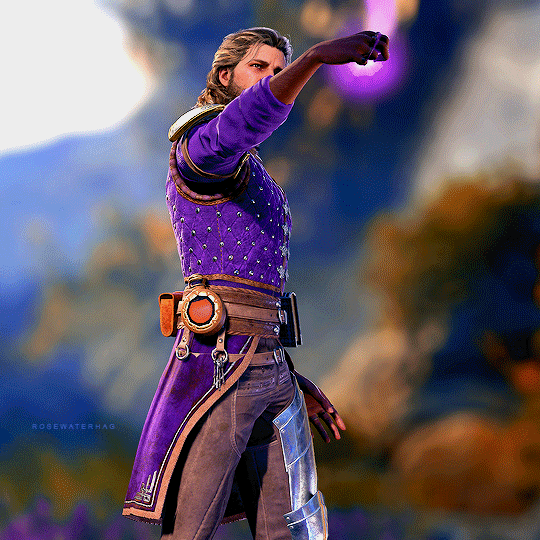
it's amazing to see not only just how quickly gale performs the somatic component of the spell, but also his efficiency of movement compared to the standard wizard animation.
there's a world of difference here, the difference between a wizard vs a prodigy, an archwizard and chosen.
#gale dekarios#gale of waterdeep#baldur's gate 3#bg3#baldurs gate 3#ch: gale dekarios#vg: baldur's gate 3#series: baldur's gate#meta: mybg3#i saw someone say in the tags once that faerun can be happy that gale is kind and good-hearted and not v much like the typical(tm) wizard#in dnd#and yeah.................................
6K notes
·
View notes
Text
Lily Evans is not just a wife or a mother. Repeat after me, Lily Evans is not just a wife or a mother. Motherhood and marriage are not the only things she's capable of. We're better than the terf that wrote her.
#i always try to only write Evans and not Potter cus let's be honest anyone marrying her would change their own last name#lily evans#feminism#harry potter#dead gay wizards#james potter#marauders era#dead gay witches#marylily#narlily#dorlily#pandalily#regulily#bartylily#jegulily#lily evans meta#fuck jkr#fanon#hp marauders#the marauders era#marauder era#marauders
684 notes
·
View notes
Text
Fridge thought fully like, twenty years later, when thinking about the concept in Young Wizards about how a wizard is picked to be offered wizardry and given an Ordeal because they're potentially the exact right person for a particular problem:
So Dairine, given the power of wizardry, decides to go find Darth Vader and kick his ass, right?
And there’s like some discussion about how, if she uses her raw wizardly power to ‘go find Darth Vader’ then she’s inevitably going to end up attracting the attention of the universe’s equivalent thereof.
Which okay, I always just nodded along to the logic of, big bad guy=big bad guy, and treated it more as a humorous bit, than something fundamental to the entire dang plot.
Because what my brain somehow failed to conceptualize, (and this may have been obvious to some other people), is what happens to Darth Vader at the end of the movies
Namely. He gets redeemed, because someone is willing to reach out and help him along towards that.
She didn’t just summon the attention of the Lone Power by trying to manifest Darth Vader into the universe by sheer ten year old stubborness, she summoned SPECIFICALLY the version of the Lone Power where Reconfiguration was a built-in possibility.
#young wizards#yw meta#dairine callahan#HOW DID I NOT NOTICE THIS BEFORE#dangit dd your LAYERS#also as my sister just said when i yelled at her about this just now#in instagram dms#‘I appreciate the commitment to “Red Five”’
525 notes
·
View notes
Note
Riddle’s extremely fearful and aggressive reaction to Dumbledore when he thinks he’s a doctor (and the fact that he assumes this at all and believes he is being lied to) has some pretty dark implications (which of course no one follows up on). Do you have thoughts?
thank you very much for the ask, anon!
and yes - this has occurred to me too... which means that my thoughts come with a trigger warning for the sexual abuse of a child, and are under the cut.
the relevant scene in canon is, of course, this:
“I am Professor Dumbledore.” “Professor?” repeated Riddle. He looked wary. “Is that like doctor? What are you here for? Did she get you in to have a look at me?” He was pointing at the door through which Mrs. Cole had just left. “No, no,” said Dumbledore, smiling. “I don’t believe you,” said Riddle. “She wants me looked at, doesn’t she? Tell the truth!” He spoke the last three words with a ringing force that was almost shocking. It was a command, and it sounded as though he had given it many times before. His eyes had widened and he was glaring at Dumbledore, who made no response except to continue smiling pleasantly. After a few seconds Riddle stopped glaring, though he looked, if anything, warier still. “Who are you?” “I have told you. My name is Professor Dumbledore and I work at a school called Hogwarts. I have come to offer you a place at my school - your new school, if you would like to come.” Riddle’s reaction to this was most surprising. He leapt from the bed and backed away from Dumbledore, looking furious. “You can’t kid me! The asylum, that’s where you’re from, isn’t it? ‘Professor,’ yes, of course - well, I’m not going, see? That old cat’s the one who should be in the asylum. I never did anything to little Amy Benson or Dennis Bishop, and you can ask them, they’ll tell you!”
the surface-level reading of this scene - which is clearly what the text wants us to go for - is that riddle thinks he's about to be institutionalised for being "mad" - and, specifically, that he thinks that what dumbledore has been told is his "madness" is actually his magic.
[he is also clearly meant to be read as panicking a little bit that he's fucked around torturing his fellow children and is now about to find out...]
that riddle accepts he's a wizard so easily - and that he is so reassured by dumbledore agreeing that he's not mad - is something the text wants us to read as sinister. him immediately describing himself as "special" is set up as a precursor to the adult voldemort's delusions of grandeur - which the entire arc of the series, ending in his death as an ordinary man, is designed to undermine.
but i've always disliked this reading. the eleven-year-old riddle - a magical child raised around non-magical people - is objectively correct to describe his powers as "special" [in that they make him identifiably different from the crowd] within the context in which he lives. the word choice is nowhere near as deep as dumbledore decides - he's clearly known since he was very young that he's a wizard, but he didn't have the precise language to describe this fundamental part of himself until dumbledore offered it; prior to that, "special" is a perfectly reasonable alternative term.
and, in always knowing that he's a wizard, he also knows that he doesn't have a mental illness - but he must also know that this is something it's near impossible for him to prove.
in the real world, if i spoke to a patient who told me:
“I can make things move without touching them. I can make animals do what I want them to do, without training them. I can make bad things happen to people who annoy me. I can make them hurt if I want to.”
then i would be correct to describe them as experiencing psychosis. and i might - depending on their other symptoms - have reasonable cause to admit them [voluntarily or not] for psychiatric treatment.
riddle is - of course - demonstrably not psychotic. but it's not unreasonable that mrs cole would assume he is - the world she lives in, as a muggle [even if she's a religious one], is one in which people do not possess the ability to move objects or control animals with their minds, and if one of her charges is convinced that he can, then she's justified in seeking medical intervention.
[that psychiatric treatment in the 1930s can be described without exaggeration as inhumane is another matter...]
which is to say, i think we can easily suppose that mrs cole has - prior to dumbledore's arrival - succeeded in having riddle "looked at", and that the idea that he's mentally ill and should be committed to an asylum has been mentioned before. i think most of us would be instinctively [and angrily] wary of doctors if this happened to us, regardless of how nice the doctors in question were.
and maybe that's all there is to it.
and maybe it isn't...
in the doylist text, the eleven-year-old riddle's personality is the way it is because he's the villain of the series. where harry is preternaturally capable, even as a child, of all the things the series defines as admirable - above all, enduring difficulty without complaint - riddle is preternaturally incapable of them. he's meant to come across as unambiguously sinister - and the fact that the text repeatedly emphasises that he has control over his unpleasant traits invites us to view him as someone who is acting with full agency. that he lives in an orphanage is a trope which the text uses, like a campy horror film might, predominately to underscore how creepy he is - and the text, in keeping with its general lack of interest in states and their institutions, never really prompts us to interrogate the impact of his childhood upon the course his life takes.
[this is despite the fact that voldemort's reliving of the night he killed the potters in deathly hallows is an incredibly accurate depiction of ptsd...]
but it's also the case that the eleven-year-old riddle's behaviour and personality fits a pattern we might expect to see in a child who is being abused, sexually or otherwise:
he's aggressive, he has a hair-trigger temper, and he becomes distressed even by behaviour - such as dumbledore speaking mildly and calmly - which would not ordinarily be expected to provoke such a reaction.
his broader emotional state is fractious. his mood changes sharply, he seems to feel emotions very profoundly, he struggles to control his emotional response to things, he's extremely easily irritated, he's attention-seeking - and he particularly seeks negative attention, and he's very highly-strung. his admission in deathly hallows that he feels calm before he kills - or before he otherwise eradicates a threat or a problem - comes with the flip-side that he's someone who appears, when things aren't going well or he finds himself in a situation which he can't control, to become quite anxious. which is a trauma response.
he's extremely isolated. the text presents the fact that he has no friends as a deliberate choice - "lord voldemort has never had a friend, nor do i believe that he has ever wanted one" - and his relationship with everyone else he ever meets, including his fellow orphans, is defined by the text as exclusively involving him controlling, manipulating, and punishing them. or: he is always the more powerful person in the pairing. but this need for control can be read as self-protective just as easily as it can be read as sinister. there are hints in canon that riddle is not just some malevolent force in the orphanage preying on mild-mannered innocents. for example, billy stubbs, the owner of the rabbit he kills, is targeted by riddle as revenge: “Billy Stubbs’s rabbit... well, Tom said he didn’t do it and I don’t see how he could have done, but even so, it didn’t hang itself from the rafters, did it? [...] But I’m jiggered if I know how he got up there to do it. All I know is he and Billy had argued the day before." on the rare occasions billy turns up in fics, he's usually - i find - written very like neville - sweet and guileless and a bit pathetic. but the alternative reading - especially when we take into account that riddle attacks the rabbit rather than billy himself - is that billy is someone he would be afraid to physically confront. indeed, it's striking that voldemort - at all stages of his life - is described as being quite physically fragile. not only is he very thin, but he's always cold and his heartbeat is described several times in canon as irregular. i think this is supposed to be a comment on the physical changes he undergoes the more horcruxes he makes - although the idea that the soul would affect the heart doesn't actually align with how the series understands the soul to relate to the body - but it can also be interpreted perfectly legitimately as something he was experiencing prior to splitting his soul. i am committed to the headcanon that riddle was quite a sickly child - and that this is one of the things which drives his fear of death - and i'm also committed to the idea that his obsession with magic is because the enormity of his magical power makes up for his physical lack. he can defeat - and humiliate and frighten and remove the threat of - billy or dennis [or even an adult man?] with magic. without it, if they were to physically overpower him, then he wouldn't be able to throw them off.
he is extremely nervous about being alone in a room with dumbledore - someone he doesn't know, and who he assumes is connected to a profession [and, maybe, who knows any other doctors he's been previously made to see...] of which he is frightened.
he doesn't trust or confide in anyone - which, as a child, means particularly that he doesn't trust or confide in adults in positions of responsibility. he's clearly uneasy with the idea of finding himself in the subordinate position in an adult-child relationship when dumbledore offers to take him shopping for school supplies - potentially because he's worried that dumbledore will try and dictate or restrict what he's allowed to buy unless he behaves in a certain way... and i am always very struck that dumbledore says in half-blood prince: "He was very guarded with me; he felt, I am sure, that in the thrill of discovering his true identity he had told me a little too much. He was careful never to reveal as much again." this is presented in the text as evidence that dumbledore is the only person of whom voldemort is afraid - by which the text means that voldemort acknowledges that dumbledore knows that an ordinary man, mortal and unimpressive, lurks behind the mask of unassailable power he has created for himself; and which the text thinks is a good thing. but we can also read it as a self-protective act on riddle's part. in his excitement, he offers dumbledore information [that he is known to be a liar, that he is in trouble a lot, that mrs cole dislikes him and is disinclined to believe anything he says] which would give dumbledore - or anyone in a similar position of power and presumed respectability - cover to abuse him, safe in the knowledge that he would be unlikely to be believed if he reported it.
he doesn't appear to feel safe in the orphanage and he's frequently absent from it - by his own admission, he spends a huge amount of time wandering around london on his own, which may even involve him staying away for several days at a time. nobody appears to notice or care about this.
he's very independent - which the text again presents as evidence of his deliberate self-isolation and rejection of the bonds of love and friendship - and his independence is unusual for a child his age [i.e. that he is capable of doing all his own shopping for school].
his knowledge of violence - i.e. how he designs the trip to the cave to be maximally psychologically devastating for dennis and amy and devoid of repercussions for himself - is also more advanced and methodical than would be expected in a child of his age. again, the text uses this to emphasise how inextricable the child-voldemort is from his adult self - and also, to some extent, to underscore the intellectual brilliance [his magic is also more advanced than is normal for a child] which his narrative archetype [the exceptional villain who is defeated by the everyman hero] requires. but we can also read it as evidence of his own victimisation. a common sign that a child is being sexually abused is that they display a knowledge of sexual behaviour which is more advanced than is reasonable for a child of their age - for example, knowing in detail how a sex act is performed, or fluently using sexual slang which they have no chance of knowing either from age-appropriate settings like school-based sex education or conversations with a parent or trusted adult, or from the sort of enthusiastic hoarding of rude words and phrases all children enjoy as they grow up. riddle's precise, clinical knowledge of how to manipulate, frighten, torture, and control can be seen as something similar. if he can - at eleven or younger - methodically break down another child until they're "never quite right" again, then this is because he's learned how to from someone.
he keeps secrets. and he also goes out of his way to extract them. his grooming of ginny in chamber of secrets - he manipulates her into confiding things she wants to keep to herself, promises he won't tell anyone, and then uses the threat that he will to get her to do his bidding - is an absolutely textbook example of how abusers use the idea of secrecy to control their victims. it doesn't make his abuse of ginny any less inexcusable if we assume he learns this from being on the other side of things.
dumbledore understands his little cache of objects as trophies he's taken from victims - and the text takes the view that dumbledore is correct in this assessment. that hoarding trophies is something widely associated with serial killers means that this is yet another thing which underlines how creepy - and how like his adult self - the child-voldemort is. but it's also the case that the adult - and teenage - voldemort places a lot of emphasis on gift-giving as part of his control over other people. the two most obvious examples in canon are wormtail being given his shiny hand as a reward for helping voldemort get his body back, and slughorn being buttered up with crystallised pineapple before voldemort asks him about horcruxes. the text thinks this is sinister - and one of the reasons it does this is because gift-giving is a grooming tactic. the text also clearly thinks this isn't behaviour voldemort has learned from the other side. and yet a common sign that a child is being abused is if they have possessions it doesn't make sense for them to own [i.e. a child from a low-income background who is suddenly decked in designer clothes] and which they can't or won't explain how they came by. riddle's cache isn't luxurious - although he's so poor that a yoyo or a mouth organ probably is a luxury to him - but there's also nothing in canon which precludes the objects being presents, rather than stolen goods. if the spell dumbledore uses to make the box rattle is caused by a statement which is both relatively ambiguous and dependent on dumbledore's subjective personal morality - is there anything in this room he's acquired through nefarious means? - then the spell would still work as it does in canon if riddle was an abuse victim given the objects as "rewards". dumbledore's tendency to locate right and wrong in the individual and dumbledore's belief that good people should steadfastly endure misery means he can be written entirely canon-coherently as someone who would think a victim who appeared to collude in their own abuse - such as a victim who "offered" a sexual act because their abuser promised them something if they did - was behaving consensually, manipulatively, and nefariously. and it's worth noting that when riddle doesn't know what dumbledore has done to make the box rattle, he is "unnerved". when he realises dumbledore thinks he's stolen the objects - and that he has no interest in forcing him to admit this aloud - he is "unabashed". perhaps because he's just received proof that an experience he doesn't want to talk about is still secret...
on the other hand, the objects could indeed be stolen - because petty criminality and anti-social behaviour, especially in pre-teen children, is also a sign of abuse.
he can be extremely obsequious - when dumbledore tells him to watch how he speaks he becomes "unrecognisably polite", he ruthlessly flatters slughorn, and he is cringingly deferential to hepzibah smith. the text understands this as evidence that his apparent charm is only superficial - another trait associated in the popular imagination with serial killers [and it's striking that so much about the young voldemort - handsome, charming, seemingly quiet and polite, true evil lurking underneath the mask - is exactly like the pop-culture persona which has been created for ted bundy...]. voldemort himself agrees that his charm is performative in chamber of secrets: “If I say it myself, Harry, I’ve always been able to charm the people I needed. So Ginny poured out her soul to me, and her soul happened to be exactly what I wanted." but his obsequiousness is also a fawn response - a way of minimising a threat by attempting to please the person issuing it. he becomes "unrecognisably polite" - after all - in response to this: Dumbledore raised his eyebrows. “If, as I take it, you are accepting your place at Hogwarts - ” “Of course I am!” “Then you will address me as ‘Professor’ or ‘sir.’ ” Riddle’s expression hardened for the most fleeting moment before he said, in an unrecognisably polite voice, “I’m sorry, sir. I meant - please, Professor, could you show me - ?” riddle could reasonably interpret what dumbledore says here as a threat to prevent him attending hogwarts - even though dumbledore evidently doesn't mean it in this way - and he switches to being fawning because this is something he really doesn't want to happen...
do i think that any of this is what the text was actually going for? no. and nor do i think that reading riddle as a victim of abuse excuses the violence which the adult voldemort goes on to perpetuate.
but i think it is a reading of his characterisation which is both canon-plausible and interesting - a strange, sickly child with a reputation for cruelty and dishonesty being abused by the respectable doctor who is constantly called in to treat his coughs and wheezes, who buys him little presents and charms him into telling him secrets, who then [to paraphrase the teenage voldemort] feeds him a few secrets of his own, safe in the knowledge that nobody will ever believe him if he tries to get help.
and i also think this a reading which is sincerely important.
a significant contributor to the prevalence of child abuse - no matter what exact form this abuse takes - is that we are culturally conditioned to imagine that both the abuser and the victim will look and behave in a certain way if the abuse is "real".
and this means, all too often, that we take child abuse more seriously when the victim is "sympathetic" - when they're from a stable home, and their family are respectable, and they do well in school, and they're polite and sweet, and they look innocent, and they behave perfectly appropriately for their age, and nobody would ever dare to say that they come across as older than they are, and they're white, and they don't have a history of lying, and they don't have a history of attention-seeking, and they don't have a criminal record, and they're not abusive themselves, and there's absolutely no way of suggesting that they colluded in their abuse, and the perpetrator was someone who looks like a child abuser.
someone who is creepy, low-status, ugly, unpopular. someone who everyone can tell is socially abnormal, someone who nobody would ever intentionally permit to be around their children. not someone who is charming, well-respected, attractive, rich, popular, trustworthy. not someone who has a loving family and a happy home. not someone we might be friends with.
but many perpetrators of child abuse are these second group of people. and many victims of child abuse are "unsympathetic", when their social positions and reputations are compared to their abusers' own.
they lie. they steal. they're attention-seeking. they're vindictive. they have trouble distinguishing between imagination and reality. they're violent. they're bullies. they hurt animals. they abuse other children. they take drugs. they're mentally-ill. they come from broken homes. they're in the care of the state. they're dirty. they're poor. they're odd. they're behind at school and badly-behaved in the classroom. they do things which allow their abuse to be dismissed as something they brought upon themselves - they speak or dress in certain ways, they pose provocatively in pictures and post them on the internet, they are known to be sexually active outside of the context of their abuse, they lie about being over the age of consent, they engage in sexual behaviour with an adult abuser in a way which appears [even though it isn't, and there's never a circumstance in which it will be] to be consensual or for their own personal gain, they are flattered by the attention they receive from someone who is important or attractive grooming them, they have complicated - and not always wholly negative - feelings towards their abusers.
and they are still - unequivocally - victims, and what happens to them is still - unequivocally - abuse.
tom riddle is an unsympathetic victim - not only of any potential abuse, but also of the horrors of his life which are explicit on the canon page: that he is raised in an orphanage; that he is grieving; that he knows nothing about his family; that he is thought to be mad.
the absence of any institutional response to his childhood experiences - dumbledore, by his own admission, discloses nothing about riddle to his fellow teachers - is a flaw repeated again and again in the worldbuilding of the harry potter series.
hogwarts - and the wizarding [and muggle] state more broadly - doesn't intervene in any case of neglect or abuse, from harry to snape to voldemort's own parents. the series' individualistic morality means that we aren't supposed to interrogate these collective failings. and the series' black-and-white view of good and evil - and its general belief that violence is fine if the person it happens to "deserves" it - means that it has no interest in examining the ways that poverty, isolation, and neglect are risk factors; that straightforwardly unpleasant people can still be victims; that victims can go on to become perpetrators without their victimhood ceasing to matter; and that the abuse of children usually takes place not in silence and secrecy, concealed in ways which make it fine for adults not to notice it and not to intervene, but in plain sight.
this is knowledge it never hurts to refresh. thinking about lord voldemort's childhood might be an usual way of doing so... but it is an effective one nonetheless...
#asks answered#asenora meta#tom riddle#lord voldemort#if wizards had the concept of safeguarding it would be a game changer...
563 notes
·
View notes
Text

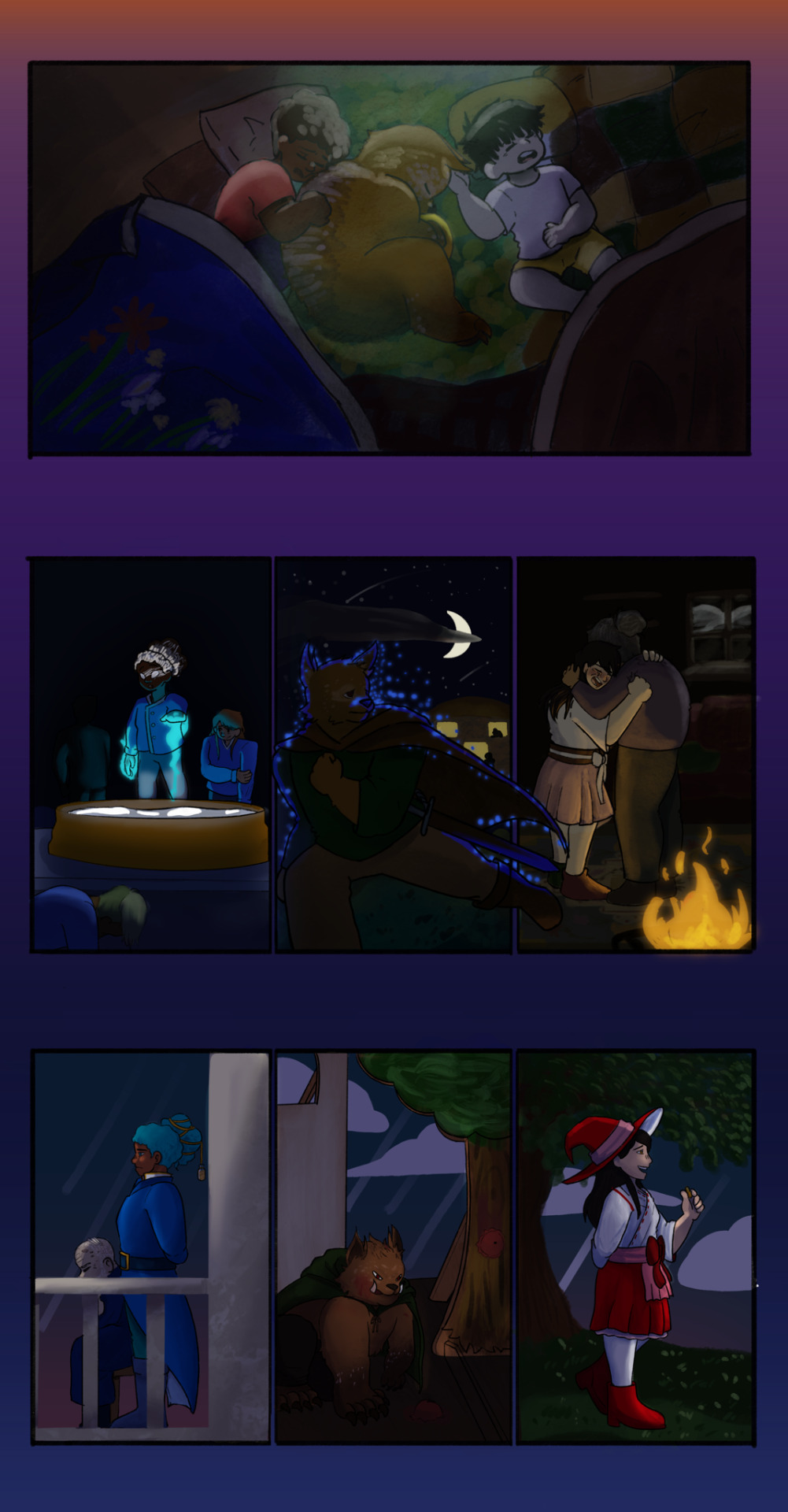



#worlds beyond number#wbn spoilers#I am. not normal about this podcast#this took me three weeks and I felt crazy while making it#I have a lot of. meta art thoughts while I made this. which was fun#eursulon#ame#suvirin kedberiket#the wizard sky#the wizard the witch and the wild one#wwwo spoilers
676 notes
·
View notes
Text
911 and the Wizard of Oz!
So I’ve written a couple of times about the wizard of Oz connections that 911 has had in the past. Well after 8x03 and the trailer for 8x04 - everything has become much clearer to me and boy oh boy is Tim pulling a blinder with this one!
I need to start by saying he is playing on lore from both the original books as well as the film, so much of this wouldn’t be evident if you had little to no knowledge of the book series. I however do - because I loved the books as a child and I have also long been interested in the link between the books, the original film and the queer narrative that runs through them. Especially because of my yellow and blue and then blue and green colour theory and its use in telling queer narratives in cinema and television in the aftermath of the 1939 film.
For those who don’t know the background of it, you can read my post here about the wizard of oz and its queer narrative and the yellow/blue colour theme, but for a brief run down the wizard of oz and its themes have been a key part of the queer narrative since they first appeared in print and then on film. Yellow blue colour theory stems from Dorothys dress and the yellow brick road and became a film short hand for queer narratives in film, during the hays code era (1934-1968), and has continued on to this day. the most recent and most obvious use of the blue/yellow blue/green coding has been in heartsotopper - where it is very heavily and very cleverly used to help tell the queer narrative, but it is its use in films during the hays code where it was doing a lot of work to ‘secretly’ provide queer narrative in film. (this is a specialist subject of mine and I could write about it all day - I really would love to do a phd in it, but I do not have the money or time to do that so I write about it at any opportunity on tumblr!)
Many of the nods to the story are subtle, but they are there and I am going to go through a good number of them with you - especially the ones we’ve had in season 8 so far, the main thing to note right off the bat though is that they all connect in to Eddie and that is very telling to me - especially when we take 5x01 - 5x04 into account. the rest is below the cut becasue it's long!
The very first reference to the Wizard of Oz we get is in 202 - 7.1. We have the entitled woman (that is the name they gave the character in the credits!) with her dog - Paisley.The entitled woman is wearing red shoes and we get shown her with just her feet sticking out from under the rubble in a clear nod to the wicked witch of the east being buried under Dorothys house in Oz.

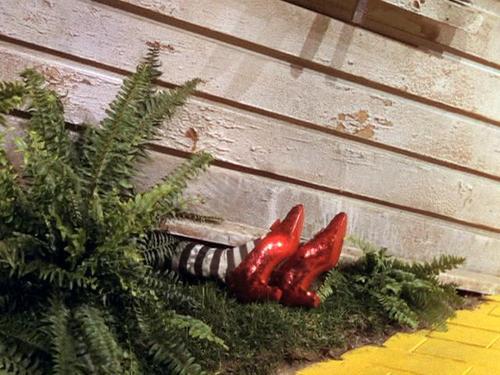
Kat the little girl who gets separated from her family and ultimately reunited with them is a nod to the overall story of Dorothy in the wizard of Oz - and Paisley is a nod to Toto - Dorothy’s dog. I will also mention the fact that we get a heart metaphor during this disaster - Jeff - the heart of a champion.
We get a further nod in season 2 in 207 - Haunted - where we have the girl at the halloween parade dressed as the film version of Dorothy. I don’t think there is a huge amount to read into from a Wizard of Oz perspective, beyond the fact that it is referenced - we don’t actually need to see anything further in regards to the Wizard of Oz - its all about making the connection.

This episode is a big episode of Eddie and his storyline and this is a way for 911 to link Eddie into the Wizard of Oz theme without being massively obvious about it and his absence from this scene is a key part of that.
There are other key elements in this scene that we’ve been seeing come into play over the seasons for Eddie and that is what makes the wizard of Oz reference especially interesting. First up it's important to note that this is the episode we see the return of Shannon in. We have the horse and his rider - being separated by the death of the horse and the officer describing the horse as his friend. There are two things this is playing on here - the first is the foreshadowing of Shannons death, the second is that the show has then reused this metaphor of partners being separated by death, this time making use of the police aspect as a part of Eddies breakdown in season 5 - Mills’s - Eddies partner while he was in the army and her death. These two elements are why Eddie absence is key - Eddie becomes the officer and Shannon or Mills becomes the Horse and having Eddie present in the scene waters down the metaphor.
The fact we get a lot of wizard of Oz references in season 5, makes this a really interesting and clever connection to draw. The other aspects of this scene in 207 is the pretty important reference about the horse needing a sedative to stop him thrashing around until his heart gave out. Bearing in mind this is the first really intentional heart metaphor we see on the show and it’s a pretty key episode for Eddie in relation to his heart, his absence from this scene becomes louder, especially as he is off with his heart (Christopher) enjoying halloween. It makes it clear that the Eddie and hearts metaphor has been there since very early on - and has been (at least loosely)connected to The Wizard of Oz.
Remembering what I said above and in my other post about the wizard of Oz being very heavily connected to queer theming and storytelling in media it makes it likely that this is the show putting in early building blocks for a queer Eddie arc gif they wanted to then go down that route later on. (this makes the season 5 theming I’ll talk about shortly even more interesting to me!)
The last thing to mention is the is the emphasis on the devil, a priest and a drag queen at the parade- all things we see appearing in Eddies arc through season n7 and into 8. The drag queens from the bachelor party - in which we really see Eddie letting go and have fun for the first time. The priest and the devil are a metaphor for Eddies struggles with his faith - the idea of temptation (in the catholic church - especially the devout catholic church, being queer in any way is seen as being tempted by the devil), and with us having knowledge of Eddie going to church and likely talking to a priest in some capacity in the next few episodes, we have yet another tie back to this storyline from 207.

Now I obviously have no proof with what the intentions were for ~Eddie in season 5, but I’ve long had my theories and now, knowing that they had originally intended to have Bucks bisexual arc take place in s5 but it got shut down by the higher ups, I can make some pretty educated guesses based off what we did get early on in the season.
Season 5 opened with the blackout and then we led straight in to 5x04 ‘Home and Away’ with all its yellow and blue colour theming. Can you see where I’m going with this? How does the opening of the film version of the Wizard of Oz start? Yup that’s right - in black and white and then when Dorothy finds herself over the rainbow everything is in colour and the use of yellow and blue is very strong with Dorothy’s blue gingham dress and the yellow brick road with the green colouring coming later on when they reach the emerald city.

So I think 911 was intending to play on that concept in season 5 - the idea that the black out is a nod to Kansas being in black and white (not to mention the use of green for the hackers!) and then 5x04 is a play on Dorothy following the yellow brick road - hence the heavy use of yellow and blue and the way it winds through the narrative of the episode (along with the use of the bluejay as the schools animal emblem - which is a symbol of communication, curiosity and confidence - seeing a bluejay is telling you to be bold and chase your goals!). What is the other thing we get a huge number of references to in season 5 - especially connected to Eddie - hearts and heart metaphors.
We do also get a nod to the wizard of Oz in season 6 and the zeppelin disaster - which is a nod to the hot air balloon the wizard crashed into Oz in. The zeppelin is yellow and blue and the conversation on board refers to one of the pilots mother in law - whilst she isn’t stated to be a witch, the implication is there. the 110 is also closed in roughly the same place as we get it closed in 8x03. along with the fact that Eddie is the one to go into the zeppelin - Chim and Buck only partially go in - and the parallel storyline in the episode is about a heart issue, we once again have The Wizard of Oz being tied into heart metaphors.

Let’s move on to season 8 now and look at the vast number of Wizard of Oz references we have seen so far and appear to have coming up in 8x04. I will say the sheer number of references in season 8 compared with the more subtle ones from seasons 5 and 6 is one of the reasons I’m so very sure we have a queer Eddie arc going on - that they’ve finally been able to pull that trigger and move things forward for him.
Just remember that things don’t have to exactly follow the story of the wizard of Oz to be relevant - its not about the narrative following the same path, but more about the use of recognised aspects and tropes from the book and film to convey information and aid the storytelling. It is often more about the concept and meaning behind something and a 911 character may share the traits of more than one wizard of oz character because it is their traits that are relevant not necessarily TWoO characters full journey through the book or film.
The bee-nado is a literal reference to the tornado that sent Dorothy to oz - its one of the reasons we don’t see more of the bees - they serve their purpose in the same way the tornado does so we don’t need to see them again.
Gerrard building ‘his 118’ with a security fence around the firehouse and cast iron plumbing is a reference to the wizard building the Emerald city - which has a wall around it for security. In Oz it is the place full o the most up to date technology etc. So Gerrard is building his Emerald City.
The mother in the car falling asleep due to anaphylaxis is likely a reference to the poppy field in the film version of TWoO, along with the flowers at the perfume launch and Bucks statement that ‘smoke worked last time’ - because the smoke did make the bees sleepy like the poppies made Dorothy and her friends sleepy.
Bucks plan to have Eddie run and attract the the swarm of bees is a reference to an event that happens in the book. The wicked witch sends a swarm of bees to sting them to death. The tin man and scarecrow had seen them coming and scarecrow comes up with a plan - he has Dorothy, toto and the lion covered in his straw to hide them from the bees who only find the tin man - they try to sting him but it breaks their stings and kills them instead without hurting the tin man as he is impervious to bees by nature of being made of tin. What we see happen in 801 is very clearly placing Buck into the role of Scarecrow and Eddie into the role of tin man - Buck comes up with the plan and Eddie undertakes it successfully - his turnouts protecting him from the bees just like the tin man being made of tin protected him.

Gerrard hitting his head is a reference to Dorothy hitting her head in the tornado and waking up in Oz - its a reference to Dororthy’s line ‘Toto, I have a feeling we’re not in Kansas anymore’ - its a play on the fact that the 118 is a very different place to when Gerrard was removed first time. Gerrard represents the black and white world - outdated and not up with the times (which he wasn’t back in the day either but that’s kind of the point), the world (the 118) is now in glorious technicolour since his departure and Gerrard will end up back in a black and white world in the end while the rest of the 118 will remain in colour and move forward. This places Gerrard in the role of the Wizard, but it is more akin to the book wizard than the film wizard - originally in the books (it was later glossed over as it didn’t go down well with readers) the Wizard arrives in a hot air balloon and becomes ruler of Oz by usurping he King and handing over the princess to a witch (more on this later!). As is shown in the film, he leaves Oz to return home in a hot air balloon. If Gerrard is the wizard, this makes Bobby the king (usurped from his throne at the 118) and Hen becomes Ozma (this is something I will talk about a bit later as it deserves its own section!) which fits with how we are being shown Hen being given the 118 captains role on a more frequent basis - suggesting the show is transitioning her into becoming the captain down the line.
Tia, her dog and Jordan are an interesting trio - they are a very clear parallel serve as a multi layered allegory as they play on several aspects of the film and books, as well as linking to aspects of 911 and especially on Buck and Eddies storyline.
Firstly we have the dog - who is the same type of dog as Paisley from season 2 - right down to the red bow in the hair (which is encouraging us to draw parallels with the earthquake disaster). Both dogs are a nod to Toto - Dorothy’s dog in the Wizard of Oz. The dog is also a representation of Buck, but I’ll go into that when I talk about Buck below!


Tia represents both Dorothy and the tin man, we see her initially as, not heartless, but guarded, but she softens especially when we see her following the instructions Hen gives, and bonding with various people on the plane including Jordan, in much the same way we see the tin man do for Dorothy and scarecrow. She is also a representation of Eddie (again I’ll go into this more later on)
Jordan is a reference to both the flying monkeys (through his telephone conversation he is implied to be a business monkey which is in turn a play on monkey business - behaviour that causes discomfort our annoyance) and the cowardly lion. He is also a reference to Chopfyt who only appears in the books and is a man made from the parts of others and is a reference to Tommy, which I will explain later as well!
its worth pointing out that Jordans viagra fuelled boner is hidden under a rainbow towel and when they get off the plane Tia, Jordan and the dog are sat on a yellow tarpaulin - the implication being that they are still in Oz and over the rainbow, but that isn't real life - its fake - a dream - and reaity will set back in once they are able to go home.

Buck has 2 red flares to bring the plane home - symbolic of the red slippers - click three times and say there’s no place like home.
There is a lot of yellow and blue lighting used in combination - especially around Buck and Eddie.
The green lighting on the plane after it has landed - a reference to leaving the Emerald city and Oz and going home.
Im sure there are others that I may have missed, but these are the key ones, and most of them will likely remain in play in some capacity in the upcoming episodes.
As for the potential upcoming oz references, we have the following
the tiger in 804 is likely a reference to lions and tigers and bears. Oh my! from the film, but may also be a reference to the hungry tiger from the books - who is a tiger who is never full and desires to eat a fat baby but never would as his conscience would never allow him to. He is described in the books as the largest and most powerful of his kind and is one of Ozmas chariot drivers and is friends with the cowardly lion. The Tiger reference coming in no place like home and the books connection of the tiger with Princess Ozma and the cowardly lion makes me feel like Karen may be represented by and paralleled with the tiger, and the idea that Karens conscience won’t allow her to metaphorically eat Ortiz (the fat baby) but that is purely speculation on my part!
the pumpkin stuck on a head storyline that’s been hinted at coming up in 805 - in the books there is a character called Jack pumpkin head who is made by the Princess Ozma when she is Tip and then brought to life by magic (Ozma is the rightful ruler of Oz and was given to the Witch Mombi of the North by the wizard in order to prevent he rightful ruler of Oz ascending the throne. Ozma is transformed into a boy called Tip by Mombi, but is later turned back when Glinda discovers what has happened). Im expecting this arc on the show to play into Jack’s storyline in the books. Jack refers to having lost a father when Tip is returned to being Ozma. I think we’ll see it played as a reference to Mara, Chim and Hen, because Hen is Very Ozma coded which I’ll explain a bit more later on!
Masks. with 805 being titled masks it feels very loaded towards the Wizard of oz and the fact he wears different masks (in the book) depending on who he is meeting with. He appears to Dorothy as a giant head (as we see used in the film), to the Scarecrow as a lovely lady, to the Tin Woodman as a terrible beast, and to the cowardly Lion as a ball of fire. He does this with the intention of scaring them all, but in all cases has chosen the wrong image to make the desired impression. there is of course the fact that the mask slips (the curtain gets pulled away by Toto) and the truth of the Wizard is revealed - that he is a fraud - merely a man who has been using magic tricks to make himself seem great and powerful.
these are just the ones we know about, there may very likely be more revered once we’ve seen the episodes, for example we might get a play on Eddie in church and going to confession - the idea of hiding ones identity behind a screen.
I want to talk a bit about the specifics of the firefam, and how they fit into the concept in a more detailed way. Obviously all members of the firefam fit into multiple aspects of each of the 4 main characters in Oz, but they each have one that has a stronger pull than the others. Each one of the characters in the books and film have specific traits that form their personality and a key part of their narrative - Dorothy wants to get home, The lion wants courage, the scarecrow a brain and the tin man a heart. These are all allegories for the bigger picture.
Dorothy wants to go home, yes, but that is part of her bigger desire to belong - the books reveal much more about her past and upbringing in Kansas. She is also the first person in the wider story - it is her journey that sets in motion all of the other ones.
The cowardly lion is in fact not cowardly, but incredibly brave, and a loyal friend, he is just full of self doubt because he believes his fear makes him inadequate as lions are supposed to be the king of beasts. we see him overcome that self doubt and go onto succeed - becoming a well respected and important member of Ozma'z court.
The scarecrow wants a brain but is in fact shown to be the smartest of the group - coming up with clever plans and sharing a great depth of knowledge the also becomes the ruler of the Emerald city - appointed by the wizard when he leaves, and it is stated by the tin man in one of the later books the he is ‘probably the wisest man in all Oz’
The Tin man wants a heart, but in fact is one of the most tender, emotional, considerate and caring people in Oz as well as being extremely competent and practical. He is also shown to seize up and rust due to either the rain or his tears. In the books he is given more backstory - his axe was enchanted by the wicked witch of the east and it causes him to chop off his body parts limb by limb. The witch does this because he is win love with her ward Nimmie Amee. when he chops out his heart he feels his could no longer love her and so left. he does later try to find his long lost love but is left disappointed when he finds her married to a man made up of his body parts and those of another tin man called Captain Fyter who had also been enchanted by the witch for the same reason. she refuses to leave her man of parts and tin man and scarecrow return to the emerald city together.
The Tin man and the scarecrow sit very much in parallel with one another in both the books and the 1939 film, they are very much a pair and shown to be each others foil and in the books especially spend a long time debating with one another about the relative importance of the brain and heart, but in combination with one another form a perfect whole.
With the main characters of Oz covered we can explore the way 911 is using their traits to tell the stories of our firefam, but before we do that I want to look at a few other key 911 characters and how they relate to the wizard of oz!
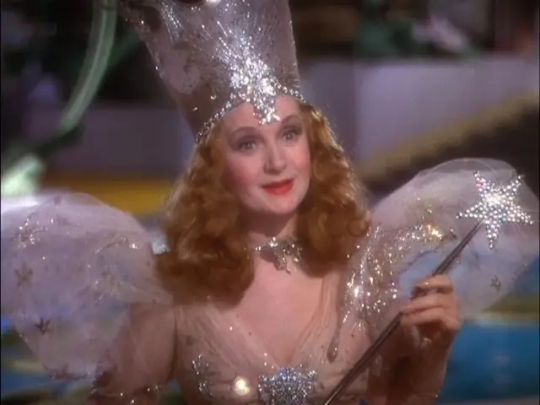
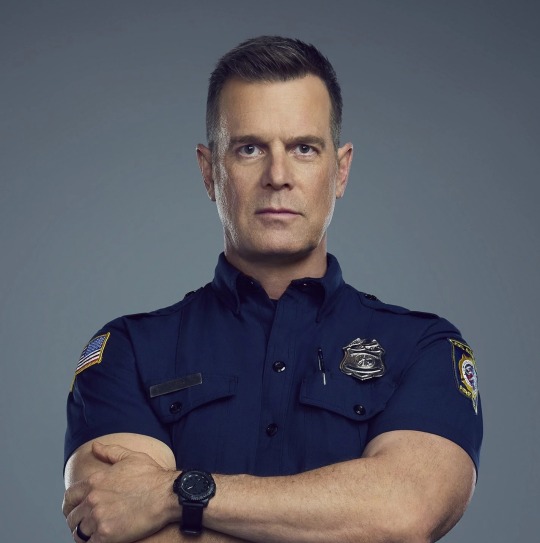
Bobby in my opinion is Glinda the good witch - he shares a lot of traits with her. It is Ginda who helps restore Oz (the 118) to its fully unified state - something that had ceased to be under the Wizard and the wicked witches rule in separate counties. She also tends not to meddle or interfere in Ozian matters unless requested to do so. This fits with bobby’s traits very well - he doesn’t tend to get involved in things unless pushed to do so or asked directly. Much earlier in Oz’s history Glinda also helps redeem the tyrannical king of Oz through the creation of the forbidden fountain and the waters of oblivion - the king drank the water and then forgets his cruel and nefarious intentions. bobby replacing Gerrard at the 118 fits fairly well into this theme.
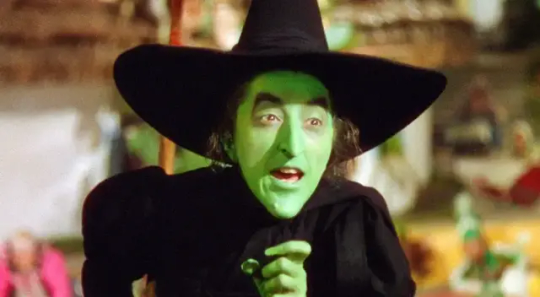
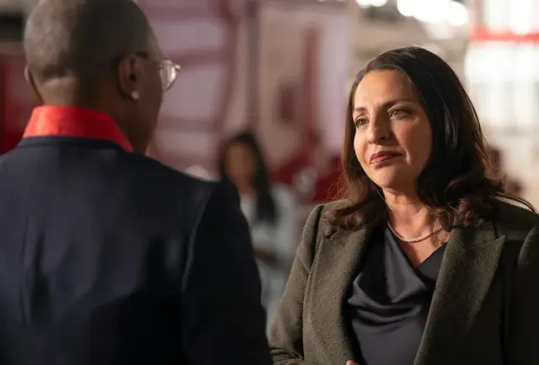
Ortiz is an interesting one - she fits into bot the role of The wizard, as well as the wicked witch of the west. I think that Ortiz is the wizard in part because the name Ortiz can loosely be read a s a play on ‘wiz’ as in wizard, but also because she is the most powerful person in the show right now - and it is all built on lies and corruption - much like the wizard is in Oz! However as the film unfolds we are shown that the witch is in fact more powerful than the wizard, but is also eventually easily brought down. This is why I think she is also a reference to the wicked witch, but also because the witch controls the flying Monkeys - who serve as her lackeys and undertake her bidding.

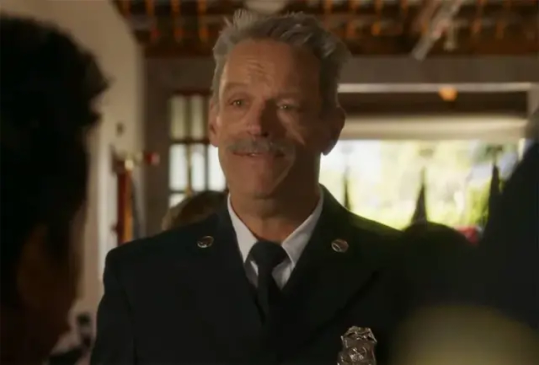
Gerrard is both the Wizard of Oz and a flying monkey. I wrote above about the wizard hiding behind screens and masks and and Gerrard and I wrote about Gerrard building fences around the 118 being reference to the wizard building the emerald city. The flying monkey connection is obvious - he is working under Ortiz.
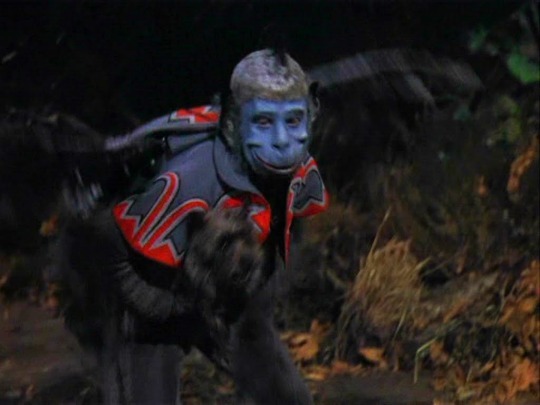

Tommy fits into a couple of different characters. He is in my opinion most closely connected to Chopfyt and Nimmie Amee, but he also fits into the meaning of the flying monkeys. Chopfyt is made up of the parts of the Tin woodman and Captain Fyter (the tin soldier) who are rivals for the attention of Nimmie Amee who is married to Chopfyt but was at one time courted by the tin man and the tin soldier. Captain Fyter and the Tin Woodman become friends during their journey to find Nimmie Amee. The flying monkey connection is perhaps a more obvious of the three, the monkeys are subservient to the wicked witch of the west and in the begins episodes we are shown Tommy being very much under Gerrard wing through his behaviour. It is also worth nothing that the flying Monkeys in the book drop the tin man over shape rocks leaving him so dented he could not move and they pull the scarecrow apart, scattering his straw and throwing his clothes up a tree - Dorothy is able to repair them both with the aid of the Winkies (the people under the control of the wicked witch of the west) and Dorothy then commands the flying monkeys to take them to the Emerald city.
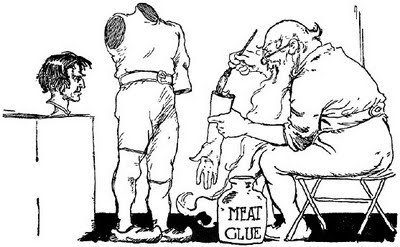
The meaning of these character connections is clear to me - Tommy as Nimmie Amee courts first the tin man (Eddie) and then the Tin Soldier (Buck) but chooses Chopfyt in the long run. Tommy is made up of parts of both Buck and Eddie in the same way that Chopfyt is made up of parts of Tin man and Captain Fyter. The fact neither Tin man or the Tin soldier succeed with Nimmie Amee and that she choses Chopfyt is telling and possibly gives us clues about the eventual demise of Buck and Tommys relationship and suggests that as tommy fits both characters parts (both characters who are fairly small roles in the books and are plot devices - much in the same way as Tommy is in 911), he will ultimately choose himself (as we’ve already seen him do in 705).
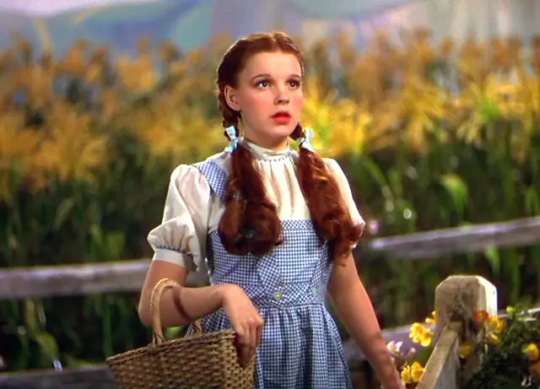
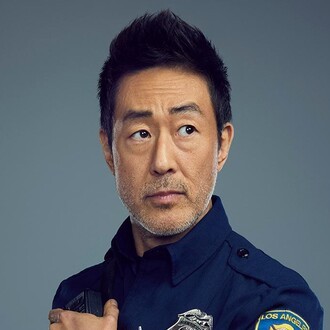
Onto the 4 remaining members of the firefam, and I believe Chimney is for the moist part, meant to be Dorothy - he is the first member of the firefam in the same way Dorothy is, he fits a lot more of the Dorothy tropes from the book than the film shows, he is described as the heart of the 118 - which is basically what Dorothy represents in the books and film - she is the one who keeps everyone together, or brings them back together when they have been separated. And if we follow the theming of Gerrard being the wicked witch of the west, it becomes more apparent - in the books Dorothy is enslaved by the wicked witch and forced to carry out menial cleaning tasks - in much the same way we see Chim being treated by Gerrard in Chim begins. It is Chim who we are shown supporting Hen, Buck, and Eddie as they begin their careers at the 118.
The other thing of note - which currently doesn’t fully work, but will if, as I suspect, the wizard of oz references around Eddie are a part of his Queer journey - is that Chimney is the only one of the four members of the team (we are not including Bobby as he is the captain) who has no queer coding in any way and is in a heterosexual marriage. The reason this is important and plays into the idea of Chim being Dorothy is that the term ‘Friend of Dorothy’ is coded speak for being queer - I explain it further in my meta which I linked at the top of this post - the play is that Dorothy herself is not queer, but that her companions on her journey down the yellow brick road are. Which fits Chimney perfectly - with Hen and Buck being Lesbian and bi respectively and with the Wizard of Oz connections to Eddies storylines across the previous seasons and again in the current season being very loud, it feels fair to assume that Eddie will also sit somewhere on the queer spectrum before too long (and really is the reason behind me writing this insanely long post!)
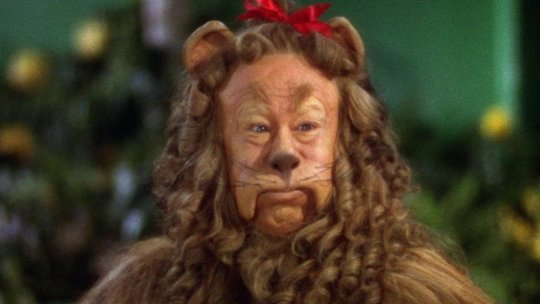
Hen is the cowardly lion. We are shown Hen doubting her abilities at several points throughout the show, but she is arguably the bravest of the 118. The cowardly lion’s favoured companion is the hungry tiger (as I wrote about above - we may well see Karen paralleled with the tiger in 804)
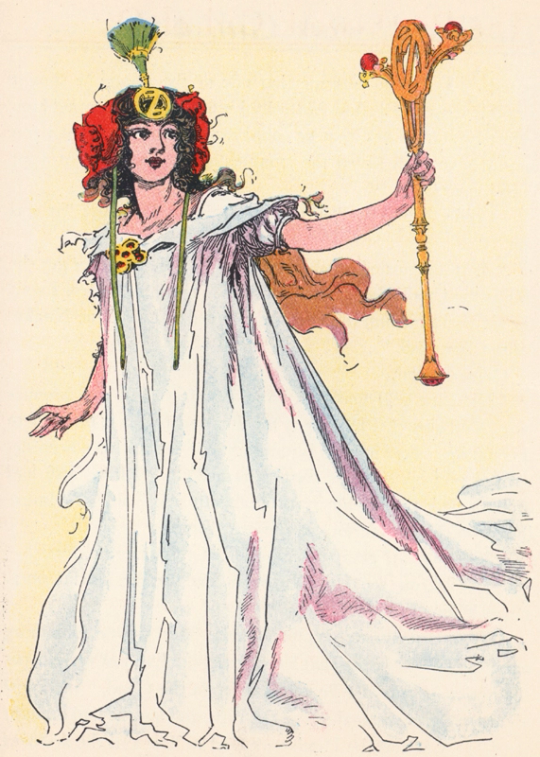
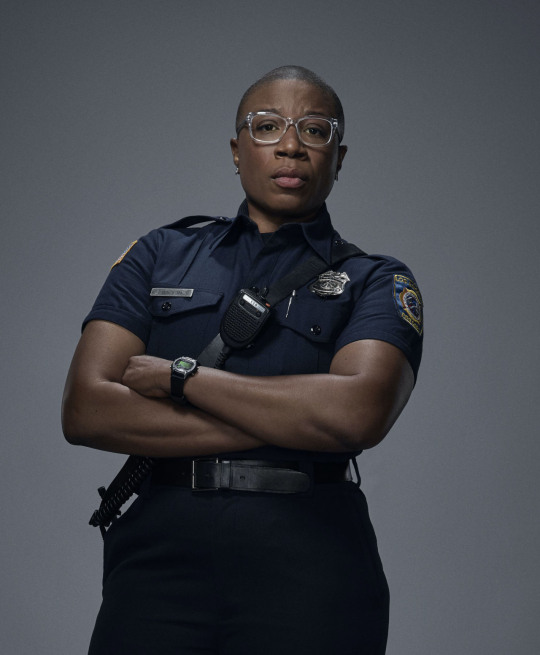
But Hen is also Princess Ozma and this is a far more powerful connection. Ozma is the rightful heir to the throne of Oz and spent much of her childhood in the form of a boy called Tip as she had been enchanted by the witch Mombi until Glinda the good witch discovers the enchantment and forces Mombi to return her to her true form and take her rightful place as ruler of Oz. With Bobby filling the role of Glinda, helping Hen achieve her full potential and the allegory of Hen having to hide herself for much of her life until she becomes a firefighter - the wig we see Hen wearing in Hen begins plays into this idea perfectly - that Hen was disguised but has been freed from that disguise and become her true self.
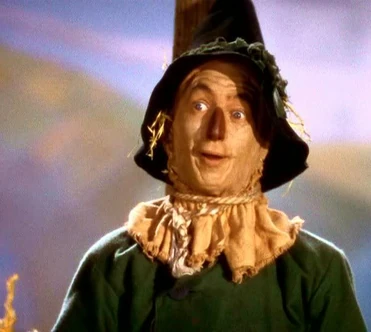

Buck is the scarecrow. But he is also Toto and Captain Fyter. I explained the Captain Fyter connection above in the section on Tommy so I won’t repeat myself here. Buck is toto for a couple of reasons. Firstly we have the connection to the dog in the plane in season 8 who growls at Jordan and Tia tells him that the dog doesn’t like men, he then becomes friendly when Jordan is ill, but we see him returned to Tia when they leave the plane. this is all a allegory for Buck’s bi arc. Tia is Eddie in the scenario and Tommy is Jordan . The dog growling and being protective is akin to Buck growling and becoming jealous over Eddie and Tommys friendship, trying to keep Tommy away from Eddie, but then becoming friendly with Tommy in the same way the dog becomes friendly with Jordan in a therapy dog kind of way before returning to Tia at the end, implying that Buck will always go back to Eddie when it comes down to it. the therapy dog aspect is also interesting as it implies BUck is providing some kind of therapy for Tommy - this could be read as Buck helping Tommy learn and grown (likely in connection with his still undressed past behaviour) - makes him a better person, before they part ways and Buck ‘returns’ to Eddie.
Then there is the wizard of oz references - it is Toto who sets much of the plot of the wizard of Oz in motion - by biting Almira Gulch in Kansas in the film version and by hiding under the bed in fright in the book version. It is Toto who reveals the truth of the Wizard of Oz being just a man, and it is Toto who leads The lion, scarecrow, and tin man to where Dorothy is after she has been captured by the wicked witch (in the film - he is less involved in the book!) and it is toto who stops Dorothy from leaving with the Wizard and ultimately leads to Dorothy learning the slippers she wears can carry her home if she clicks her heels together 3 times and wishes to go home. All of these events either play into Bucks arcs in 911 or will potentially going forward. Bucks impulsive ways could be said to mirror Toto’s impulsive actions in TWoO and it will be interesting to see if being taken under Gerrard wing leads to him gaining information that helps Hen take down Ortiz!
The biggest connection though is with the scarecrow. The scarecrow has long been associated with bisexuality - due to his line in the film ‘of course some people go both ways’. in the book the scarecrow also reveals that he lacks a brain but greatly desires one - he is in fact only 2 days old when Dorothy meets him so he is essentially just naive because as the book progresses it becomes increasingly clear he actually is very intelligent and knows many things. One of the other aspects of the scarecrow is his ability to know his own limitations and in the books he becomes ruler of Emerald city, but hands the crown over to Princess Ozma enabling her to take up her rightful position as ruler of all Oz, becoming one of her most trusted advisors. Most of these are traits that Buck shares with the scarecrow - we see season 1 buck reflected in the naijvtie of a 2 day old scarecrow, but once he hits his stride, we see that Buck is actually very intelligent, full of knowledge (random facts wiki Buck!) and comes up with great ideas - things that are being very clearly demonstrated in season 8 so far. He is also becoming much much better at knowing his limitations and that is something I think we will continue to see develop in the way it does in the scarecrow across the books.
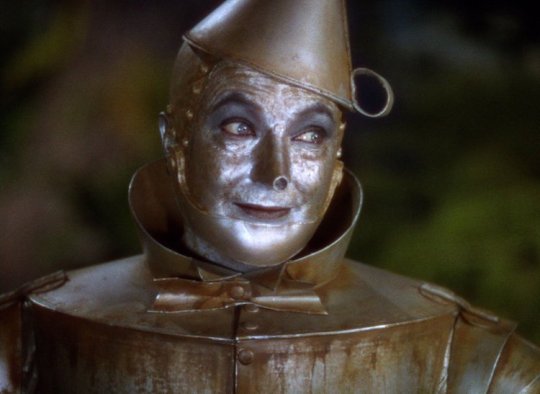
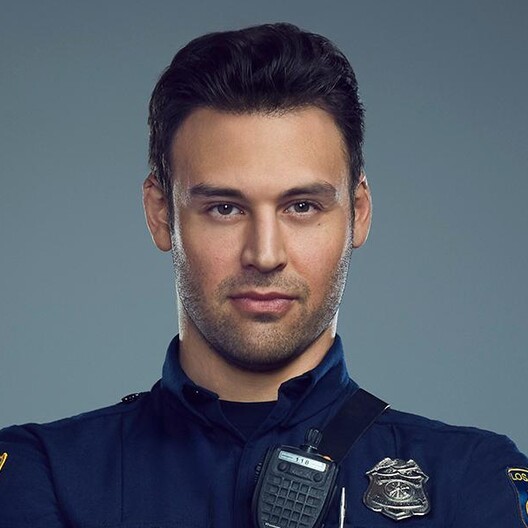
And finally we have Eddie. Eddie is the Tin man through and through. The heart metaphors that surround Eddie - especially in season 5 are a very obvious and direct link to the tin man. and Like I said above the Tin man is the most compassionate, sensitive and tender and caring people in Oz. He is incredibly practical and competent as well and undertakes the scarecrows plans readily. He and the scarecrow pair up a lot across the book series and go on adventures together, their heart and brains combining to lead them to success in nearly all cases. The tin man also becomes a trusted advisor to Ozma and is considered to be a fair and wise person in Oz. These are all things we see portrayed in Eddie. He has this tough exterior, but inside he is very soft and tender and he only reveals that side of himself to those he can trust. Eddies heart is a key part of Buck and Eddies dynamic especially in combination with Bucks brains - we are so often shown Buck having an idea and Eddie carrying it out because he trusts Buck - the perfume bee run is just the latest in a long line of them and it is a key aspect of the Tin man and Scarecrow in the Oz books. I’ve spoken above about the other aspects of the tin man and his connection with various characters, but it really is the tin man and scarecrow dynamic that is at the heart of things in the wonderful wizard of Oz book especially (pun intended!!).
All of it plays into the Oz theming we’re being shown in 911 having an important meaning and it is very much connected to Eddie far more than any other character. One can argue that the books - at their core - are about following your heart and letting it lead you to your truth and to home and that is the very heart of Eddies story. Carla’s line about making sure he’s following his heart and not Christophers rings very true, and we’ve reached a point now where Eddie has to follow his own heart, because Christopher is not in the picture and they’ve chosen to go very very hard with the wizard of Oz metaphors - building on the foundations they already created in previous seasons and now being able to bring them to fruition.
I could literally write about this all day, but this is already ridiculously long and I'm not sure it even makes sense at this point! It was only supposed to be a short post! So I’m stopping here and letting you all go back to your lives - thank you for reading especially if you've made it this far! and let me know your thoughts!💜💜💜🐝🌪🌈
Tagging a few random people just in case they're interested! @buddiediaz118 @buddie911abc @fruityfirehose @sunflowerdigs
@spotsandsocks @livingwherethesidewalkends @satvojihusana @inell @eddiedisasterdiaz @lemotmo @courtjestermerlin @lover-of-mine @lovecolibri
#kym writes very long meta!#long meta#sorry this wasn't meant to be this many words!#911 does the wizard of oz#911 abc#911 meta#the wizard of oz#the wizard of oz and queer narrative#eddie diaz#evan buckley#buddie#anti bucktommy#anti tommy kinard#911 spoilers
285 notes
·
View notes
Text
Everyone be like "I can fix him"
While rosekiller is just "I don't think he needs fixing but I can definitely make him worse"
#other ships balance each other#these two match each other's freak#and support it#hp meta#marauders era#ded gay wizards#rosekiller#barty crouch jr#evan rosier
166 notes
·
View notes
Note
I read the Young Wizards series when I was probably 10 or 11, and absolutely loved it. Specifically Deep Wizardry was incredibly important to me; it was a huge push for me to get interested in the ocean and how humans affect it.
Thank you for writing such a wonderful series, especially one that didn't simplify the complex emotions and experiences children go through. Childhood was an extremely dark point in my life, but I consistently remembered your books as a comfort and reassurance of the goodness and sheer interesting-ness of the real world. I cannot express how fascinated and joyful the world you built in those stories made me.
I've started my re-read of So You Want To Be A Wizard today, at age 20. The writing still holds up to adult-me, and I'm enjoying the book all over again. I'm looking forward to reading Deep Wizardry again especially; I'm three years into studying Oceanography and Biology.
Thank you so very, very much.
You're entirely welcome. I'm very glad the books were there for you when you needed them.
As for Deep Wizardry, at the oceanographic end— The amount of go-to-the-New-York-Public-Library-and-dig-out-the-data research I had to do for that astonishes me to this day. It was a long time before Google, and the only source of data for much of the background needed was NOAA stuff that was locally publicly available only there. (Some more info on that in this post.) The lack of even very basic maps such as this one (published three years after DW was) forced me to handcopy and merge data from various sources into homebrew mapping notes like this.
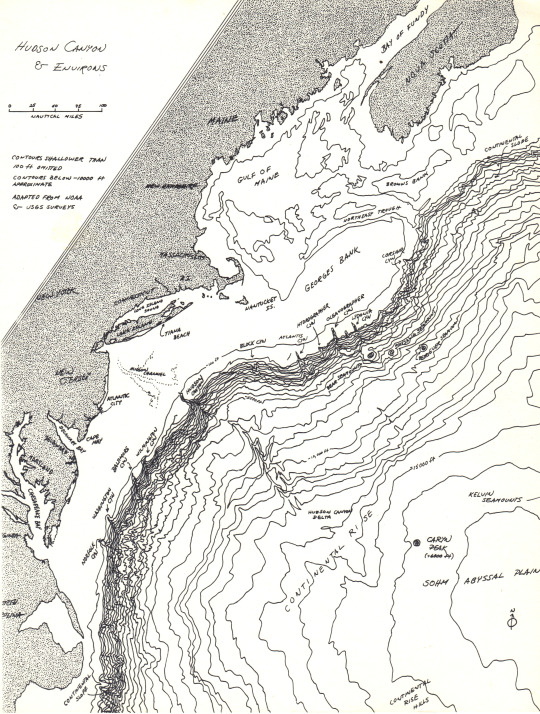
...So I have to say it's nice to discover that this doesn't stack up too badly against more modern mapping resulting from much better data. :)

And this area is apparently still on track to become a national marine sanctuary, assuming nothing goes wrong with the process secondary to yesterday's unfortunate events.
Anyway: do enjoy your reread! And thanks for letting me know about your endeavors. :)
162 notes
·
View notes
Text
So, Wizarding Robes
I saw this post by @iamnmbr3 and @kittenjammer talking about wizarding fashion and I wanted to talk about this for a while, so I'm going to give my own two cents on it based on fashion history. I love history in general, but fashion history and historical architecture are two I’m incredibly passionate about. So, here we go (post with a lot of pictures ahead):
When I read the books and they mentioned unisex “robes” which function like dresses in a way (as you don’t have to be wearing trousers beneath them:
James whirled about; a second flash of light later, Snape was hanging upside down in the air, his robes falling over his head to reveal skinny, pallid legs and a pair of graying underpants.
(OotP, 647)
And described as being very colorful and billowing, often accompanied by a pointed wizard hat, it was clear to me JKR was trying to invoke the image of the classic fantasy wizard robe:

Especially when it comes to Dumbledore.
The thing is, this style is based on a real historical period and historical styles of the medieval period in Europe.
Medieval Europian Robes
When I'm thinking about the "classic fantasy wizard look" the first historical period that comes to my mind is the 15th century and I'll illustrate why.
Spesificly, the 14th and 15th centuries houppelande. It was a long over garment that looked kinda like a dress with wide, flaring sleeves available for both men and women in various shapes, cuts, and even patterns. Here are examples of some houppelandes:
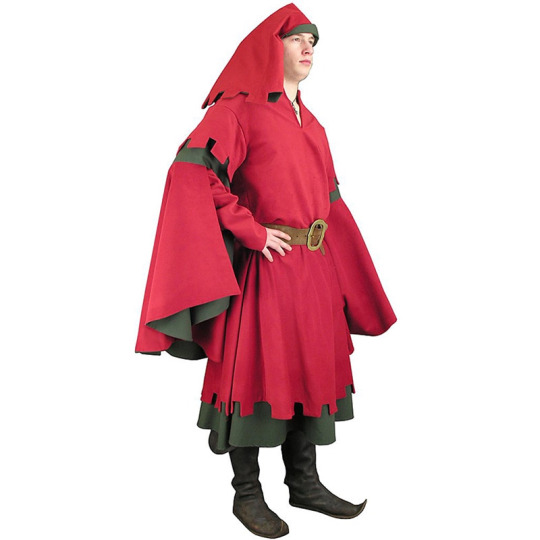
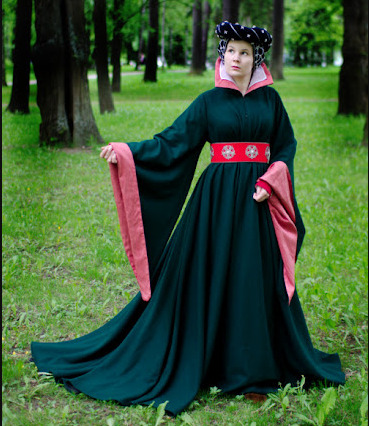

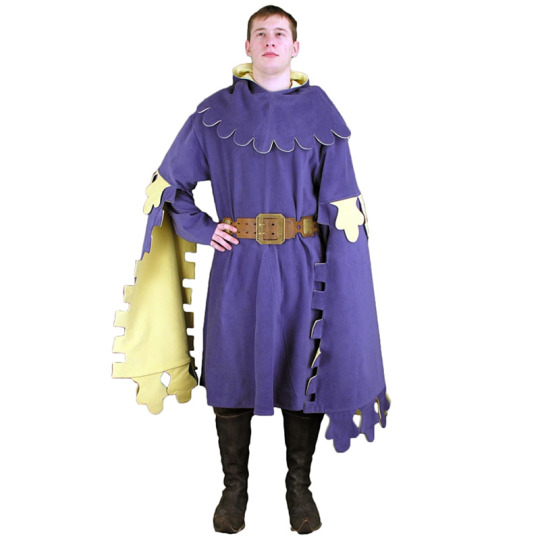

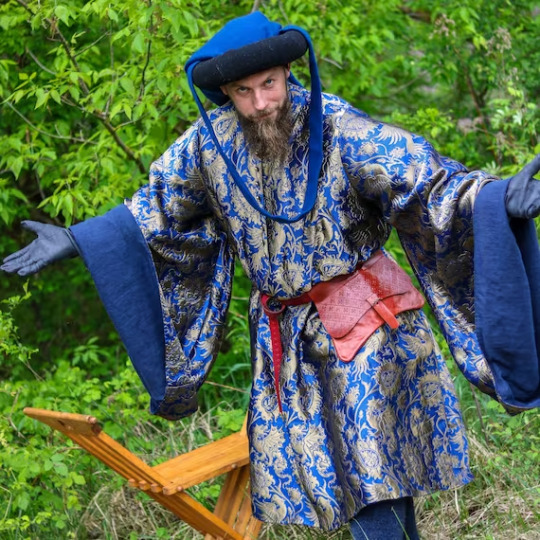
(As you can also see, early 15th-century fashion comes built-in with silly hats! Just like wizards)
In the 15th century you also have a wide array of cuts of cloaks (and even more silly hats!):
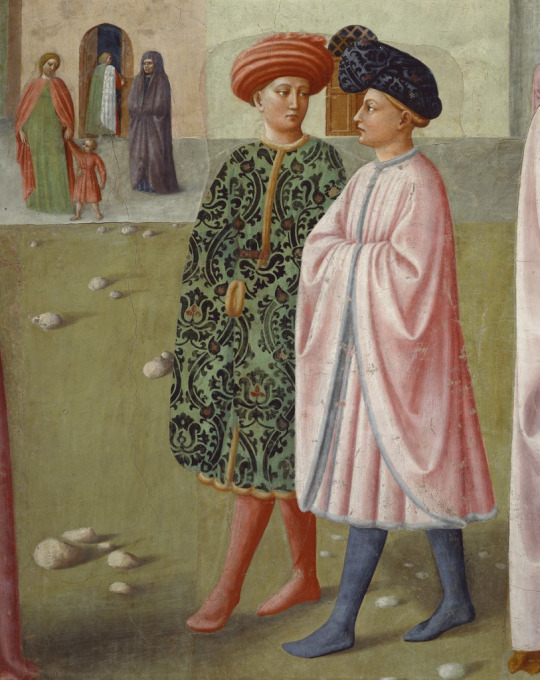
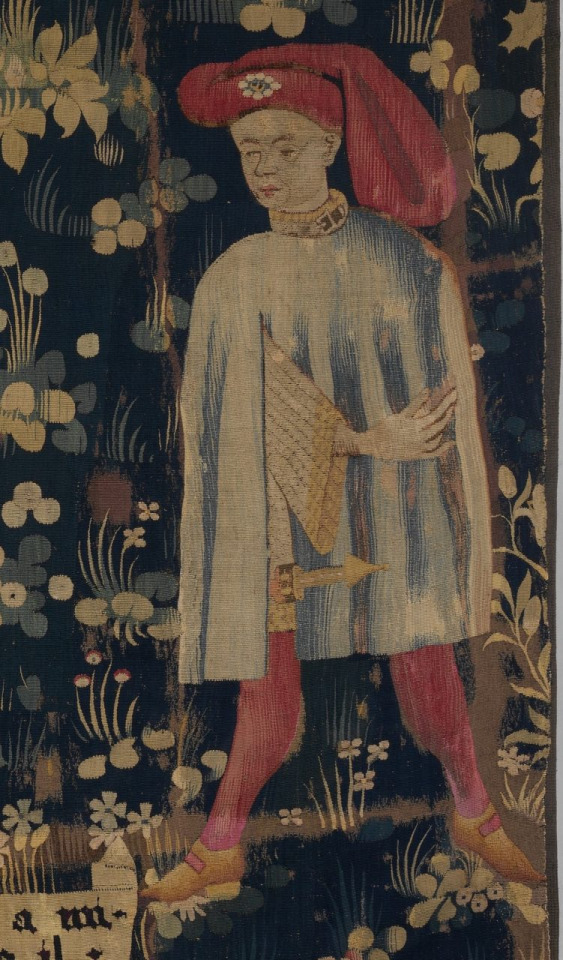
Along with surcoats, that contrary to their name, weren't just for knights to signify on their armor the house they serve:
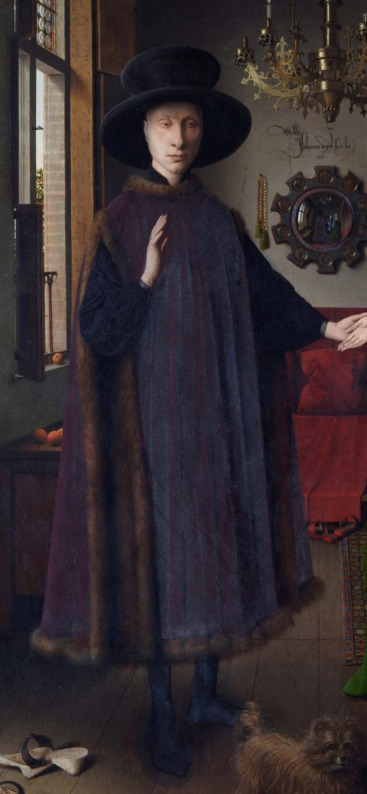
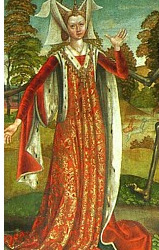
These 15th-century garments are exactly like wizard fashion is described in the books: billowing robes, colorful and eye-catching, and accompanied by silly hats.
The thing is, all these garments are from the high medieval period and as wizards broke away from muggles only when the Statute of Secrecy was enacted, I'd expect their fashion to follow the muggle trend up to that point and then start diverging. Even the most pure-blooded wizarding families of the modern day, like the Malfoys, integrated with muggle circles up until the Statue of Secrecy, something that would've forced them to dress like the muggles at the time to blend in better.
As the Status of Secrecy was first enacted in 1692, it's time to talk about:
Late 17th Century Fashion
Now, while the high middle ages in Europe had everyone wearing essentially wizard robes and silly hats on the regular, the Statue of Secrecy was enacted much later. Fashion in the 17th century was drastically different from the earlier one mentioned above.
In the late 17th century, this is the kind of dress I'd expect from women in England:
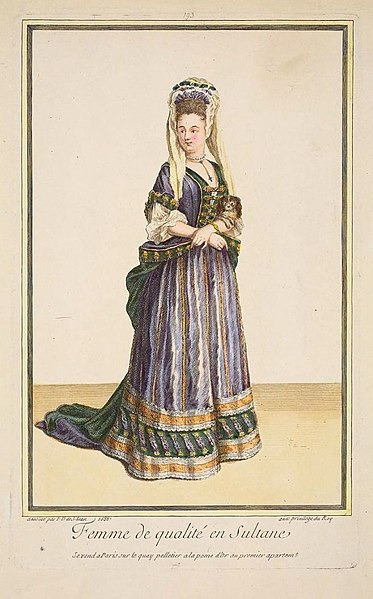
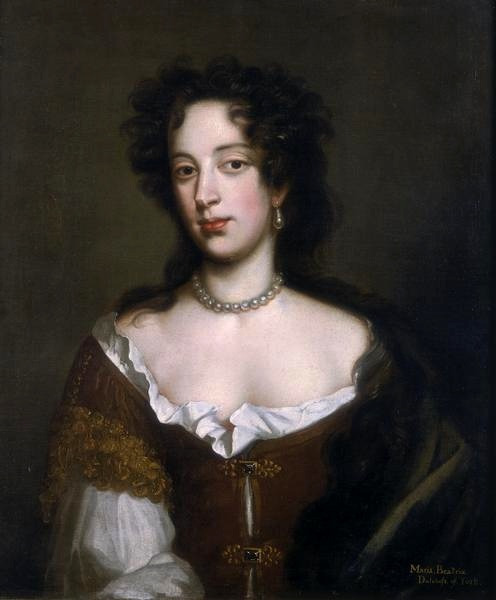
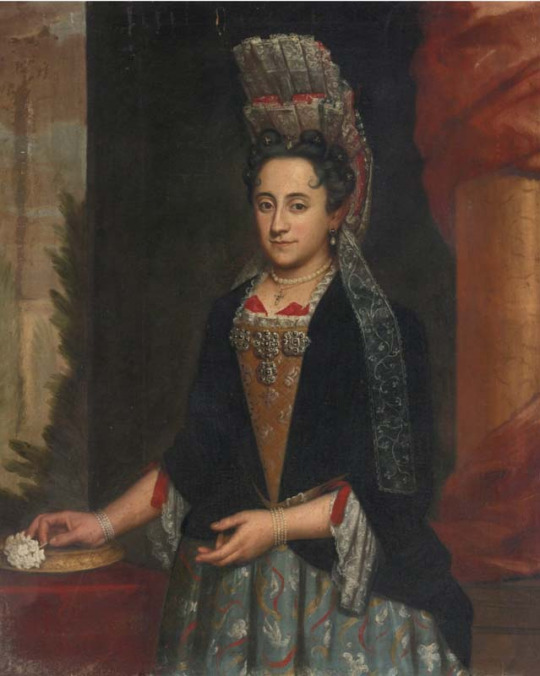

And this is what I'd expect from men:


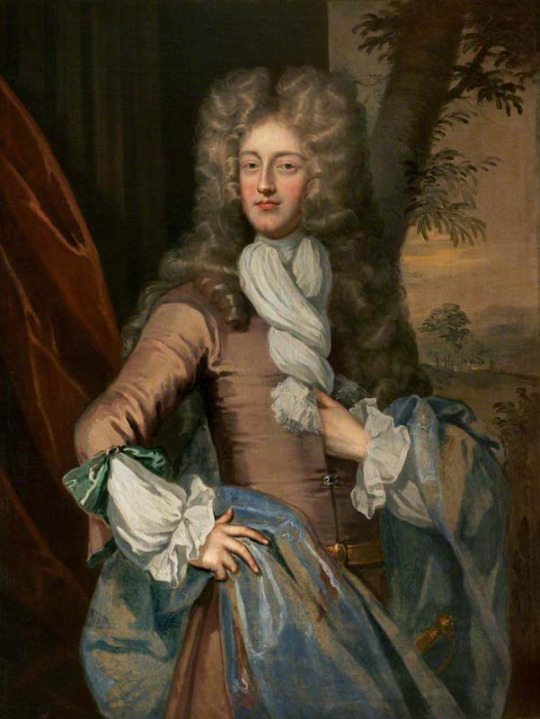
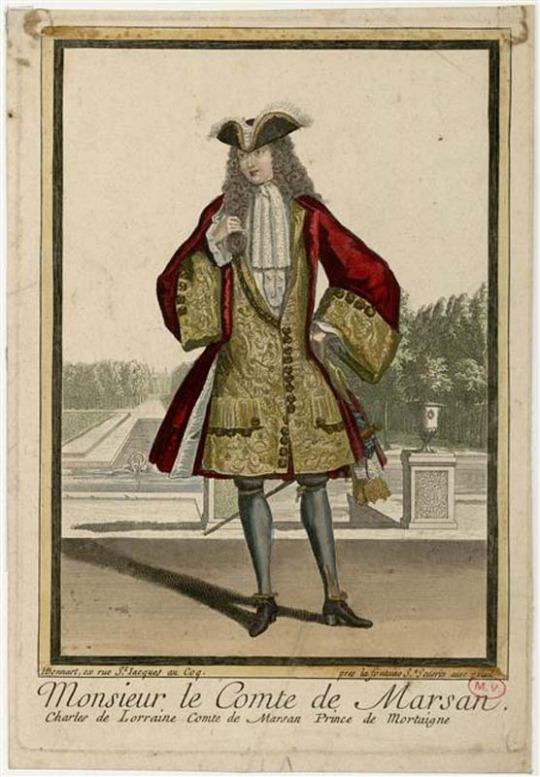
Which is very different from what is described but would've been the historical basis the wizards would work from.
So what do I think wizarding fashion is actually like?
Well, since the books are in the 1990s and wizards don't really live in a vacuum we know some later influences in fashion did make it in. So, I think wizarding fashion is an odd mix of 15th-century and late 17th-century fashions updated to the time period the wizard grew up in, hence distinct fashion changes between generations like we see in the muggle world.
We see these distinct generational fashion changes with characters like Agusta Longbottom who wears a Vulture hat. These sorts of hats with real birds on them were a thing historically. They were quite fashionable in the late Victorian era, which is when Agusta would've been a child if she's around Dumbledore's age:
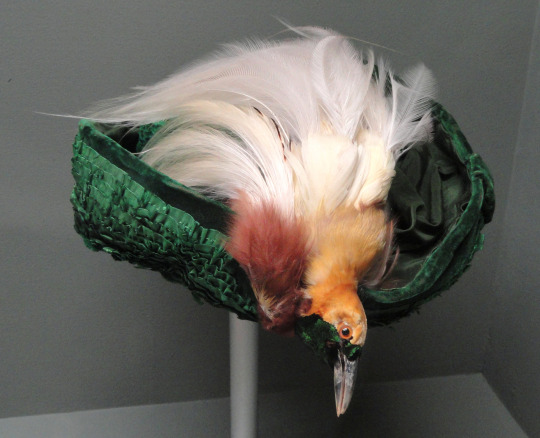

Fudge is described as wearing a Bowler Hat, a kind of hat that started catching on in the late 19th century but was still a staple in menswear into the early 20th century, hence indicating Fudge's age.
Ron's yule ball dress robes are described as old-fashioned, again indicating fashions in the wizarding world change at a similar rate to the muggle one. Note that since the 17th century, fashion has been changing quite rapidly and by the 18th century fast fashion where you need to buy new garments each "season" has already started becoming a thing. With all that, I think wizard fashion indeed changes just as rapidly as the muggle one.
Now, that's great, and all, but, what would that odd mish-mash fashion even look like?
Well, I made a few very quick sketches as concept examples for what casual wizarding fashion in the UK might look like if we're working off historical references:
(not my best pieces, it's just to get the concept across)

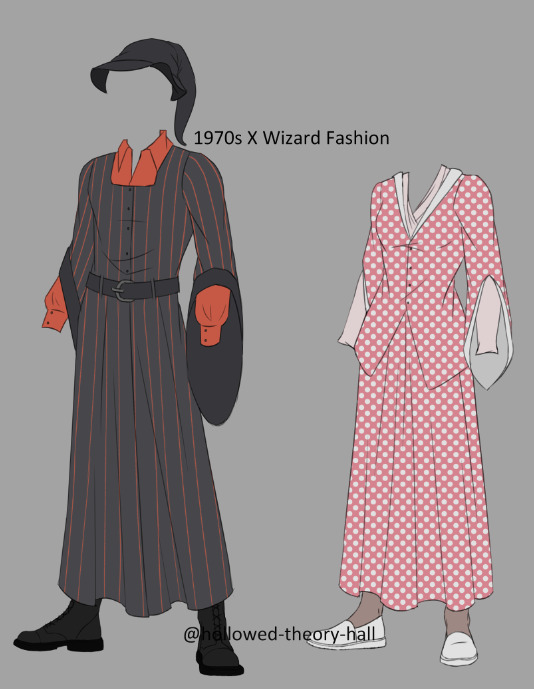

Note that Wizengamot robes and other formal professional wear would probably be older in style and closer to 17th-century fashions.
#harry potter#hp#harry potter thoughts#wizarding world#hp meta#hp headcanon#wizarding fashion#wizarding society#harry potter meta#harry potter headcanon#hollowedtheory#hollowedheadcanon#hollowedart#hollowed hp redesign
342 notes
·
View notes
Text
No but like. Where did Harry's scar come from? Because it didn't come from the Killing Curse. 1) The Avada Kedavra curse doesn't leave a mark and 2) Harry wasn't ever struck by the Avada Kedavra curse in Godric's Hollow; Voldemort was. Whatever Lily did that night caused the spell to rebound and kill Voldemort (though not permanently bc of the Horcruxes) instead of Harry.
So where did the scar come from? One option is that it is the mark left by the shattered bit of Voldemort's soul entering Harry's body. But like, why in that spot particularly? Another option is that it's connected to whatever powerful protection magic Lily invoked to save Harry. I personally subscribe to the theory that whatever she did involved some pretty scary and powerful dark blood magic, with herself - and possibly James and Voldemort as well - as blood sacrifices.
We know in the Harry Potter universe that runes are associated with ancient and powerful magic. For example the Pensieve has runes carved around the base. In book 5 a particular rune - Eihwaz - gets mentioned and Hermione says it means "defense." Now Eihwaz is a real rune in the Futhark alphabet and guess what it looks like:

...Yeah.
I think Lily was willing to go beyond the normal bounds of magic in terms of what she was willing to sacrifice. I think she cast a spell and I think her death sealed it and then Voldemort's killing curse activated it - a spell of protection so deadly and powerful that it deflected a killing curse, ripped Voldemort apart on a metaphysical level to the point his very soul shattered, and carved an indelible and visible mark of protection in Harry's skin where the killing curse should have struck him.
It's also notable that Tom Riddle resurrected himself with 3 blood sacrifices, so I kind of like the parallel of Harry also having 3 sacrifices (not just of blood but of life) protecting him - his father, his mother, and his enemy.
#Harry Potter theories#headcanons#Harry Potter headcanons#Lily Evans#meta#Harry Potter meta#my meta#my post#Harry Potter#wizarding world
217 notes
·
View notes
Text
Look, listen, this is a very important question for the culture: why does the hp fandom at large like to act like Lucius Malfoy meant to open the chamber of secrets?
Book 2 Lucius Malfoy was clearly in his live laugh love era; the Great Diary Reshuffle of 92 was very much an improv moment, a petty action to mess with a Weasley and get rid of a cursed artifact at the same time. I'm sure he went home feeling real proud of his innovative problem-solving.
Even when Draco recounts the letter from his father, all we get from Lucius is basically "sit tight and watch", not exactly the words of someone invested in the outcome.
I'm very much in the "the diary was left to Abraxas Malfoy and Lucius had no idea what it really was" camp, tho that is just a personal spice I like to add to the books, am unsure of jkr's actual intentions (if she even thought it through to that extent)
#hp#hp meta#n1 lucius malfoy apologist#(except for the wizard racism)#the malfoys#harry potter meta#the Blorger Special
172 notes
·
View notes
Text

Karlach: I found the love of my life. I'd say I'm pretty happy. Gale: And I couldn't be happier for you. A fitting reward for the sacrifices you made in getting here. Gale: I've told my students plenty of tales about our escapades. You're something of a hero to them, you know. Gale: I'd be delighted to introduce you to my current cohort - as a guest lecturer, perhaps? I'm sure they'd have plenty of questions for you. Karlach: Sorry, wiz, I'm going back to Avernus after the party. Gale: I suppose, if I were to open a contained portal in a particularly safe region of Avernus... devnote: Mulling the problem over, considering this solution Gale: No. The Blackstaff would never allow it. Health and safety, you see - it's all the rage in wizardry these days. devnote: Dismissing his previous thought - it will never work, Hint of an eye roll about the new health and safety regulations Gale: Perhaps I might come to you, then? I recently met the most excellent diabolist who should be able to lend a hand with the travel arrangements... Karlach: Sounds like you're coming to the Hells then, Gale. I can't wait. Gale: You just let me know which hill of burning sulphur to aim for, and I'll have popped through a portal before you can say 'Zariel'.
not only do i have a soft spot for karlach and gale's friendship, but gale rolling his eyes at the new health and safety regulations at blackstaff academy will never not be funny to me.
very in line with him trying to cast a spell with the blackstaff as a first year student himself, accidentally opening a portal to a different dimension, only to be greeted by a death slaad.
#gale dekarios#karlach cliffgate#gale of waterdeep#baldur's gate 3#bg3#baldurs gate 3#ch: gale dekarios#ch: karlach#vg: baldur's gate 3#series: baldur's gate#meta: mybg3#smh wizard aren't allowed to do things anymore these days
1K notes
·
View notes
Text
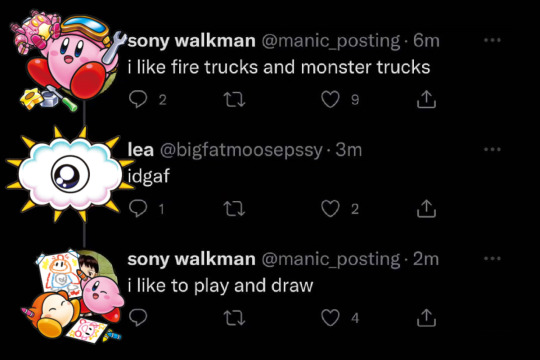
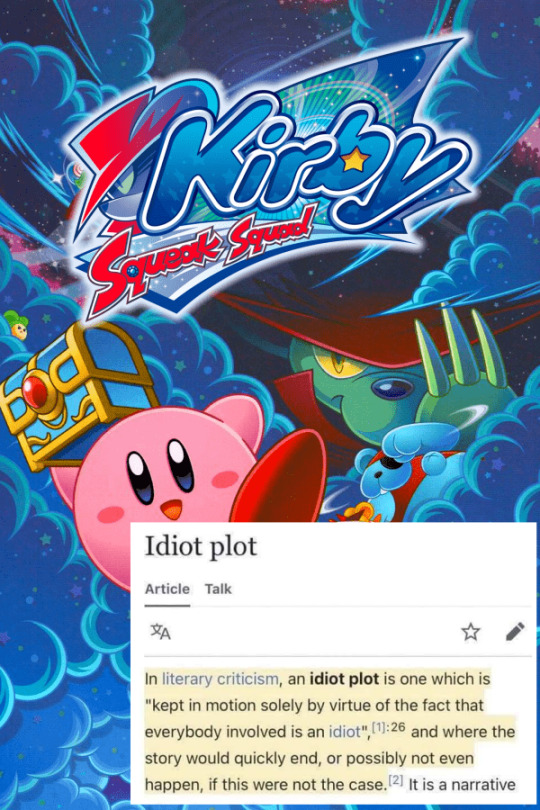
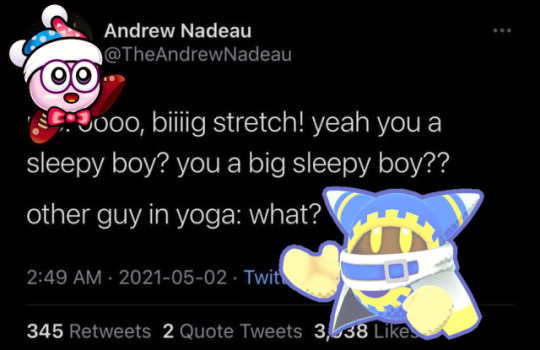
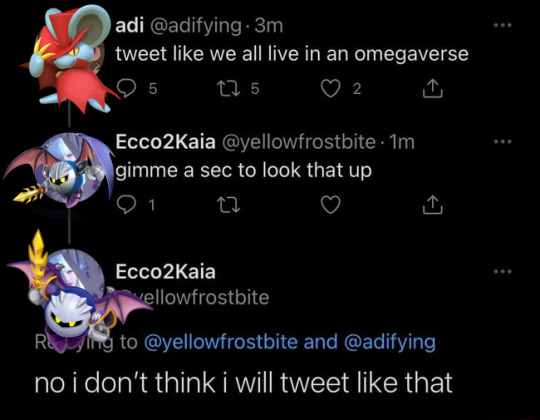
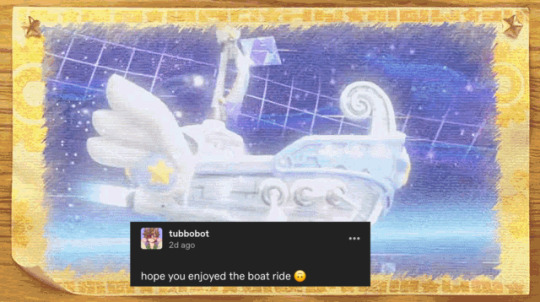
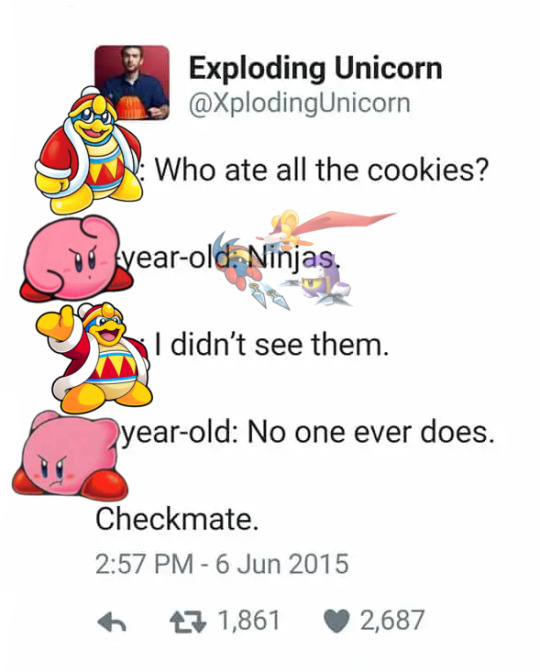


Kracko shouldn't be allowed top hater he hasn't even died
Masterpost
#kirby series#Kirby#Kracko#Daroach#Kirby Squeak Squad#marx kirby#Magolor#Meta Knight#Lor Starcutter#King Dedede#susie haltmann#Nightmare Wizard#Marx#nightmare kirby#text post memes#she speks#she speks originale#she edits#btw i put Kirby over it like that on purpose so you do have to read it as Kirby-year-old#also i picked a nightmare in dream land instead of Kirby's adventure because it was better quality 😭#all the others were so bad
363 notes
·
View notes
Text
i’d briefly like to talk about the “it was fine” dialogue option that happens the morning after gale’s Last Night Alive scene in act ii and about the fandom's general reaction to it.
gale is a character who evidently enjoys the occasional teasing. taking the piss out of your partner every once in a while can certainly be a way of showing affection. however, it is important to consider the context of the situation: what is at stake for him and his current emotional state, as well as what exactly had transpired between the two of them prior to said conversation.

gale: forgive me. these were already trying times before elminster delivered his missive. now, for me at least, they are potentially end times.
after he and tav had spent the night together and confessed their love to each other, gale is once again showing himself utterly vulnerable and is carefully asking them for reassurance.

gale: [..] i hope that night meant as much to you as it did to me.

gale: but you - you led me away from the edge.
gale: without your words, your touch... i fear i would have sought purpose and solace in that void. you reminded me what living can feel like.
he wants to check in with them, after both of them have shared something tender and very intimate, something he might even consider life-altering.

gale: we didn't just make love. we bonded, body and soul. i got lost in you.
it’s not even about gale “not being able to read social cues” and “not recognizing the fact that it was meant in jest.” in fact, i’d argue it is a rather tone-deaf, inconsiderate response and just genuinely a REALLY BAD TIME to joke at your partner's expense when they are actively baring their feelings to you and are asking you for reassurance.
i have seen people write off his reaction as “unwarranted” or “overtly dramatic” but in my humble opinion, it is pretty understandable given the nature of their conversation and what he is asking of them. it's also sad how there seems to be a general pattern of gale's emotions and boundaries getting played off as a joke, while other companions get shown the courtesy of thorough analysis/understanding. he is proud of his skill as a lover and the fact that he was able to bring them pleasure, yet his inquiry is less about him wanting tav to stroke his ego and more about him, once again, asking if you indeed share the same feelings for each other… after the emotional high has now passed.
gale has an ever-present need for clarity in his relationships, very likely due to the fact that this was something he couldn’t request of mystra. he might appear more sensitive in that regard compared to the other companions. he doesn’t want to take himself too seriously, but this still often clashes with his general feeling of inadequacy. where he is able to take criticism as long as it isn’t related to his performance, overall prowess and usefulness.
yes, his response is passive-aggressive and yes, he IS obviously hurt by what tav said. yet merely repeating “it was fine” in response to a heartfelt, genuine question could’ve as well been interpreted in that manner. if tav does clarify that they have only been joking, he apologizes to them instead. otherwise his dialogue remains the same, albeit said in a more embarrassed & awkward tone.
gale is a character who is dealing with deep-rooted self-worth issues and yet that doesn’t mean that he wants to be handled with kid gloves, far from it. he craves a relationship in which his emotional needs are recognized, respected and cared for, where he can be unabashedly open and vulnerable without facing ridicule nor pity for it. and he is more than willing to give the same in return.
also y’know — there is a time and a place.
#“briefly” they said (sorry can't shut up once i've started. you'll have to bear with me)#this has been bothering me for a while now#by all means roast your wizard to your hearts content#but maybe opt for his shortcomings that aren’t genuinely hurtful/rooted in his self-hatred#that only serve to further reinforce his belief that he is not worthy enough#when he is still very much dealing with the inevitability of his own untimely death and sacrifice#today’s lesson in empathy lmao#aka me once again getting emotionally invested in tragic pixel men#baldurs gate 3#bg3#gale dekarios#gale of waterdeep#bg3 meta#bg3 spoilers#datamined dialogue
718 notes
·
View notes
Photo
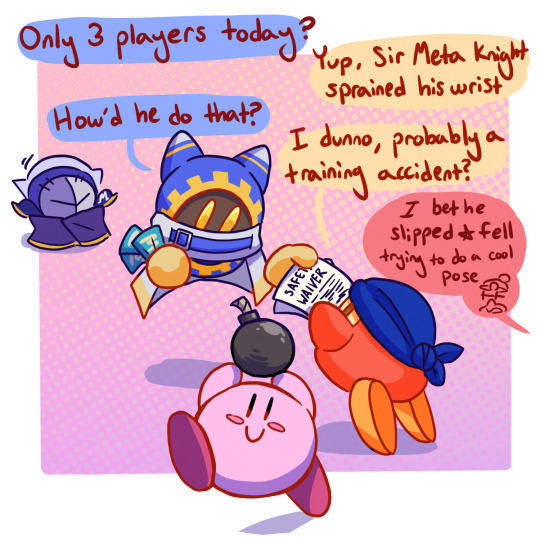

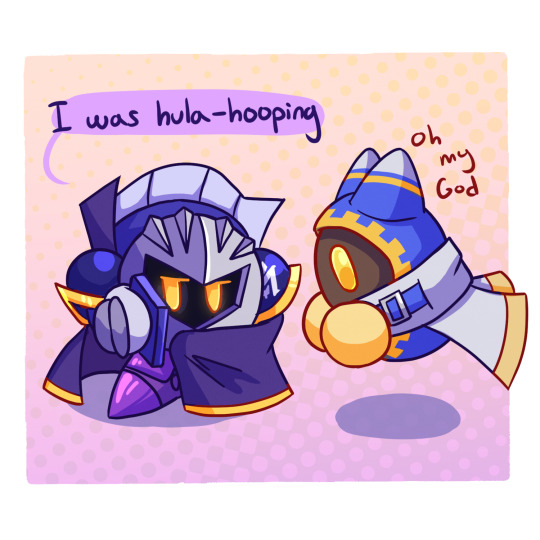

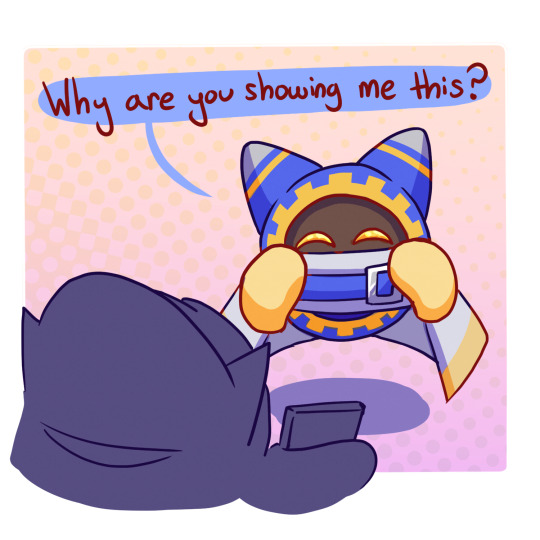
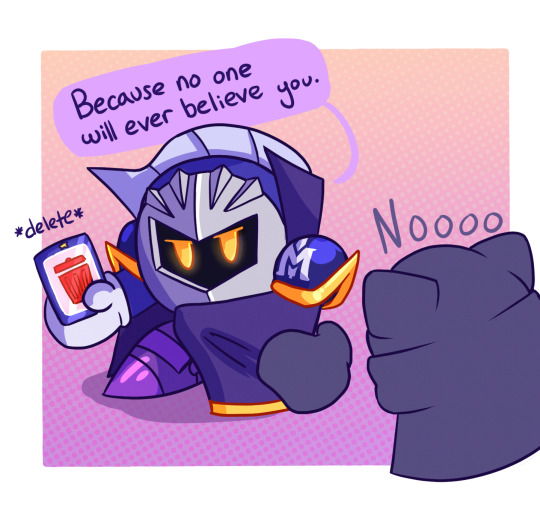
Who better to trust with a secret than a known liar?
anyways my apologies to b99 and happy countdown to the magolor bullying simulator release later this month!
#can't wait to send that silly little wizard to hell#was sort of screwing around with the backgrounds in this one hopefully it looks alright all together despite the shifting haha#meta knight#kirby#magolor#bandana waddle dee#king dedede#comic#my art#doodles#it is once again past 2am my dudes#i Refuse to edit at a sane time of day#anyways originally in panel 3 i was going to more closely parallel the b99 quote and have mk say that#he 'attends a class with captain vul for fitness and for fun'#but it got long and i didn't want to deal with shippers reading into a one off gag line lol#honestly still funny to imagine vul took the pictures though
3K notes
·
View notes
Text
The “A very frosty Christmas” chapter in HBP is so interesting to me in terms of understanding Lupin’s relation to the werewolf community. The standout line to me is this:
“‘I am not complaining; it is necessary work and who can do it better than I? However, it has been difficult gaining their trust. I bear the unmistakable signs of having tried to live among wizards, you see, whereas they have shunned normal society and live on the margins, stealing — and sometimes killing — to eat.’” (HBP, 334)
The framing of this is interesting, he didn’t say: “wizards have shunned them from normal society therefore marginalizing them so they have to steal and sometimes kill to eat”, no he puts the werewolves in the active role as if they are making a sort of choice. It effectively takes the blame off of the wizards that oppress them.
I think he might feel that it is a choice they are making. He has tried very hard all his life to fit into wizarding society. Everything he does is in an attempt to appear non threatening. He has made a choice to not live in the werewolf colonies, he’s made a choice to hold jobs, he’s made a choice to socialize with other wizards, he’s made a choice to appear civilized, he’s made a choice to conform into wizard society-
yet he is still not accepted.
The issue is not the werewolves disregarding society but a society that fundamentally disregards their humanity.
On some level he must know this yet the way he speaks about his community is dripping with a sort of self loathing that pushes for a drive for assimilation (something you can find in most groups of marginalized people).
He holds these views of achieving social mobility through the appearance of civilization while being walking proof that werewolf assimilation is futile, so he has to construct mental barriers to avoid being crushed under the weight of his own hypocrisy.
#Werewolf respectability politics#I also want to note that he is speaking to Harry a wizard here so his thoughts may be going through a filter to make him appear more -#aligned with wizard values#as a way to appear less threatening and not radical like perhaps greyback#he’s so interesting to me#love him#Remus lupin#remus lupin meta#hp meta#Harry Potter meta#hp marauders#marauders
170 notes
·
View notes